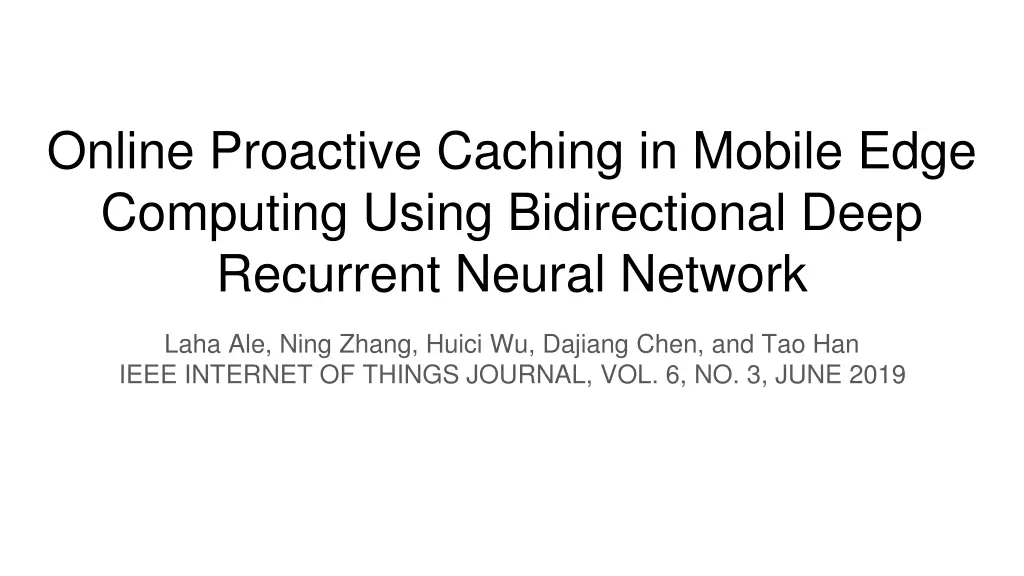
Proactive Caching with Bidirectional Neural Networks
Enhance mobile edge computing efficiency with an online proactive caching scheme utilizing bidirectional deep neural networks. Learn how machine learning methods optimize content popularity predictions to reduce latency and backhaul traffic. Explore the system model and the use of CNN, BRNN, RNN, and LSTM networks for proactive caching.
Download Presentation

Please find below an Image/Link to download the presentation.
The content on the website is provided AS IS for your information and personal use only. It may not be sold, licensed, or shared on other websites without obtaining consent from the author. If you encounter any issues during the download, it is possible that the publisher has removed the file from their server.
You are allowed to download the files provided on this website for personal or commercial use, subject to the condition that they are used lawfully. All files are the property of their respective owners.
The content on the website is provided AS IS for your information and personal use only. It may not be sold, licensed, or shared on other websites without obtaining consent from the author.
E N D
Presentation Transcript
Online Proactive Caching in Mobile Edge Computing Using Bidirectional Deep Recurrent Neural Network Laha Ale, Ning Zhang, Huici Wu, Dajiang Chen, and Tao Han IEEE INTERNET OF THINGS JOURNAL, VOL. 6, NO. 3, JUNE 2019
Problems Wireless traffic has skyrocketed Mobile edge computing can serve the demands from the devices locally and quickly Requests may exhibit certain similarity among different users over time Proactive caching can reduce traffic loads in backhaul and service latency of end users The performance of proactive caching depends on the accuracy of the prediction of content popularity Machine Learning Methods: assume the popularity of files is time-invariant An online proactive caching scheme which can predict the time-varying popularity with high accuracy and low complexity is required 2
Contributions A online proactive caching scheme to predict the future requests and manage the cache, considering the hidden association of requests in time steps. The model can achieve above 60% prediction accuracy 3
System model When request arrives, 1. check if the file is in the cache a. hit: return the content b. miss: send request to the remote cloud and reterive the content 2. deep learning model keep predicting based on requests in service zone and time steps 3. cached file updated using the predicted files (replace) 4. model keep learning Goal: improve service response time, reduce traffic loads in core network Key: predict users requests, maximize the cache hit rate 4
Online proactive caching model CNN (Convolution Neural Network) BRNN (Bidirectional Recurrent Neural Network) Traditional deep NN can t preserve learned information from previous time slots RNN with loops passes learned information from one steps to the next BRNN passes the learned information in both directions This paper uses LSTM (Long Short-Term Memory) neural network as RNN FCNN (Fully Connected Neural Network) 5
Proactive Caching CNN: encoding files into the one-hot matrix size of the convoluted values reduced, representation information of the files remains reduce dimensious of input data, reduce computational cost BRNN: adopt bidirectional LSTM to predict users sequential requests learn association of requests over time steps and output time- series user requests FCNN: sample and learn from outputs of BRNN further improve prediction performance 6
LSTM cell Forget gate Update gate memory decides what information to be kept or removed decide which candidate files created are actually related to the previous files Output gate determine the outputs, based on the cell state ltsm s output input 7
GRU: gated recurrent unit, speed up the execution speed and reduce memory consumption of LSTM Evaluation BRNN-based models can perform better than the deep NN model More epochs are required to learn the hidden information over time steps 9
Longer time steps and deeper network can improve the performance, long time steps do not compromised the performance 10
Deeper and long time steps can improve the accuracy 11
Conclusion Proposed a deep learning model based on BRNN model to predict the time- series user requests Relatively deeper LSTM layers with longer time steps can improve the performance of the models 12
